Giovanni Battista Righi was an Italian Roman Catholic priest and a professed member from the Order of Friars Minor. He was known for ascetic life and for his preaching and healing abilities.
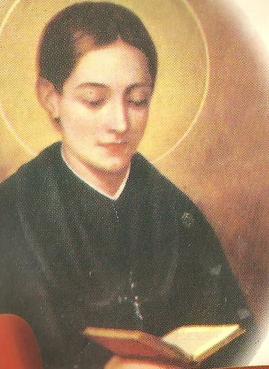
Bartolomea Capitanio was an Italian Roman Catholic professed religious and the co-foundress of the Sisters of Charity of Lovere that she established with Vincenza Gerosa. Capitanio's rather short life was dedicated to the educational needs of children and the poor and she served as a teacher for most of her life while using her order to achieve this aim.
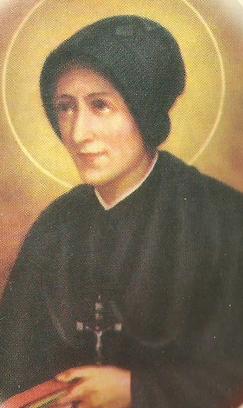
Vincenza Gerosa - born Caterina Gerosa - was an Italian Roman Catholic professed religious and the co-foundress of the Sisters of Charity of Lovere that she founded alongside Bartolomea Capitanio. Gerosa met Capitanio in 1824 and the two consecrated themselves to God in the name of educating children and tending to the poor of the Bergamo area.

Maria Crocifissa Di Rosa - born as Paola Francesca Di Rosa - was an Italian Roman Catholic professed religious and the founder of the Ancelle della carità (1839). Di Rosa worked first at her father's spinning mill where she - with his encouragement - tended to the spiritual and material needs of the female workers while gathering several women to dedicate their collective efforts to caring for the poor; this formed the basis for the establishment of her religious congregation. Her apostolate prioritized tending to the ill in hospitals and to soldiers going to the front.
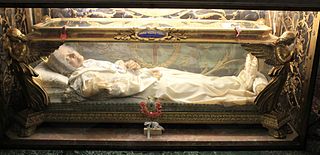
Anna Maria Taigi was an Italian Catholic professed member from the Secular Trinitarians. Taigi reportedly experienced a series of ecstasies during her life and heard the voices of God and Jesus Christ on several occasions.

Blessed Maria Pia Mastena - born Teresa Maria - was an Italian religious sister in the Roman Catholic Church. She was the founder of the Religious Sisters of the Holy Face. Mastena fostered a deep devotion to the Holy Face of Jesus and tried to promote that devotion to others in her religious career as a nun. Mastena first desired the contemplative life but was denied this after she entered the convent since it was not a cloister. Instead she dedicated herself to teaching in several Italian cities after having left another convent and another religious order when she deemed contemplative life was not the life she felt God wanted for her. Her labors were dedicated instead to consolidating a new religious congregation which began to grow after World War II until Mastena's sudden death in 1951. Mastena was beatified on 13 November 2005.

Baldassare Ravaschieri was an Italian Roman Catholic priest and a professed member of the Order of Friars Minor of the strict observance. Ravaschieri served as a noted preacher and confessor and befriended as contemporaries Blessed Bernardine of Feltre and architect Giovanni Antonio Amadeo.
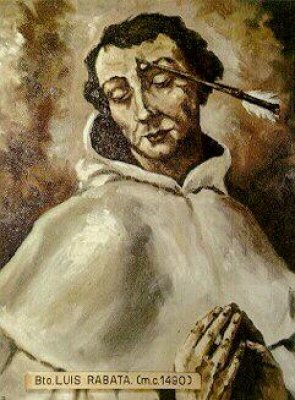
Luigi Rabatà, O.Carm was an Italian Roman Catholic priest from the Order of Carmelites. He served as prior of his convent of Randazzo until his death which occurred after an attack in which an arrow was shot into his head.

Agostina Camozzi - in religious Cristina - was an Italian Roman Catholic professed religious from the Order of Saint Augustine. Camozzi led a dissolute life as a widow and a soldier's mistress before she became a nun and adopted a life of total repentance.

Domenico Spadafora was an Italian Roman Catholic priest and a professed member of the Order of Preachers. Spadafora was a noted evangelist and attracted countless to the Dominican fold while also converting the hearts of others who led dissolute lives. He is best known for being the first superior of a church he oversaw construction of in Monte Cerignone after receiving the papal approval of Pope Alexander VI to commence such work.

Benvenuta Bojani was an Italian Roman Catholic professed member of the Third Order of Saint Dominic. Bojani dedicated her life to strict austerities as an act of repentance and devotion to God and was known to have visions of angels and demons.
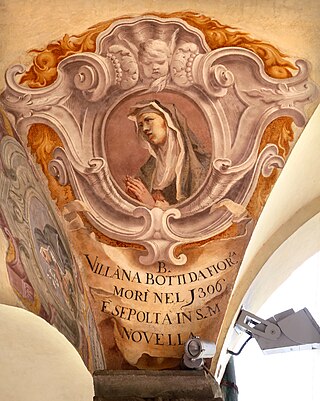
Villana de' Botti, TOSD was an Italian Catholic professed member of the Third Order of Saint Dominic. She turned to the Dominicans after a sudden conversion from a dissolute life and was noted for her simplistic life born out of her conversion. She was a pious and devoted child but after she was married she had fallen into secular values.

Elena Duglioli was an Italian Roman Catholic aristocrat from Bologna noted for her devotion to Christian life and social teachings. Duglioli wanted to become a nun for the Poor Clares but instead married in order to please her parents. Duglioli is best known for commissioning a chapel with an image of Saint Cecilia to whom she was devoted.

Elisabetta Picenardi, also known as Elisabeth of Mantua, was an Italian tertiary of the Servite Order. Picenardi was born in Mantua into a noble family and, despite pressure to wed a nobleman, insisted instead on pursuing the religious path alongside her sister.
Giulia della Rena was an Italian Roman Catholic professed member of the Order of Saint Augustine in its third order branch. Della Rena was orphaned sometime in her late childhood and sought work as a maid in Florence where she soon became a member of the Augustinian tertiaries. The religious then returned to Certaldo due to the negative Florentine economic and political climate where she became best known for rescuing a child from a burning building.

Antonio Patrizi was an Italian Roman Catholic priest and a professed member of the Order of Saint Augustine. Patrizi joined the order in Lecceto and lived as a hermit prior to his sudden death while visiting his friend at another convent.
Giacomo Benefatti was an Italian Catholic priest and professed member of the Order of Preachers who ascended to the position of Bishop of Mantua. Benefatti became noted for his tender care of the ill during epidemics of plague and both Pope Benedict XI - a close personal friend - and Pope John XXII held him in high esteem.
Elena Valentinis was an Italian Roman Catholic professed religious from the tertiaries of the Order of Saint Augustine. Valentinis was born to nobles and married a knight during her adolescence while mothering six children before she was widowed in 1441. She soon became a professed religious and dedicated herself to austerities and a life of complete penance.

Bartolomeo Fanti was an Italian Roman Catholic priest from the Carmelite order in Mantua. Fanti served as the spiritual director and rector of a religious movement in his hometown and oversaw the establishment of their rule and statutes while himself serving as a novice master for his own order where he became known for being an effective preacher.
Bonaventura Tornielli was an Italian Roman Catholic priest and a professed friar from the Servite Order. Tornielli was born into a noble household and was a noted preacher in which he visited numerous Italian cities such as Florence and Perugia - Pope Sixtus IV held him in high esteem and even named him the "Apostolic Preacher". He also held various positions of leadership within his order.
















